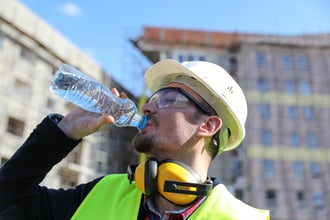Summer is upon us, and temperatures are beginning to creep up all across the United States. Now's the time to know the risks of working in the heat. Working in high heat and humidity is hard on the human body.

As employers, it's important to take precautions to make sure that all employees are kept safe. Understanding the effects of heat and humidity is important as a foundation for managing health risks.
In this blog, we will explore some hazards that heat and humidity introduce in the workplace and offer ways that you can prevent harm to your employees.
Know What the Hazards Are
High sun, heat, and humidity exposure can all pose serious health risks to those working outdoors. The first step in preventing heat illness is for you and your employees to be aware of the implications of not taking the heat seriously. Know the hazards. Health risks include:
- Heat rash
- Heat cramps
- Early heat illness
- Heat syncope
- Heat exhaustion
- Heatstroke
What are the Symptoms?
So you understand the dangers of working in the heat, but can you recognize the indicators? Common symptoms from the above conditions consist of but are not limited to:
- Nausea
- Chills
- Convulsions
- Cramping
If you or your employee experience any of these symptoms while working in the heat, seek medical attention immediately. It's important to understand that high heat exposure can lead to death.
Know How to Prevent Hazards from Happening
The best way to avoid heat-related illness and injury is to take preventative measures. Here are a few steps employers can take to prevent work hazards caused by the heat and environment:
- Provide cover from the sun. This will help avoid heat stress and other health risks from developing.
- Be careful with new employees working in the heat. They have a higher risk of developing heat stress.
- Provide water at all times to your employees and allow for frequent water breaks.
- Have your employees wear light-colored, long-sleeved clothing that is loose-fitting and breathable (like cotton). Doing so will help avoid skin exposure to poison ivy and fire ants.
- Inspect work areas for hazards as a proactive measure. If there is a large hornet nest, realize this could cause harm to your employees.
- Be aware of the heat index at all times.
- Educate your employees on the risks of high heat and humidity.
Environmental Hazards
The sun and heat can directly and severely impact the human body, but secondary hazards in the environment can also pose a threat to safety. Frigid weather has its hazards, but the summertime has its own unique risks, too, including an increase in insect activity and plant growth.
It is important to take precautionary measures at new locations where your employees will be working. Survey the area in advance to gain an understanding of the environmental risks. Some of the common hazards you may find are:

- Fire ants
- Mosquitoes (West Nile)
- Hornets
- Bees
- Snakes
- Ticks
- Poison ivy
Educate Your Employees
As employers, it's important to understand the effect of heat and humidity, but it is also important that your employees are trained and understand the effects as well. They should know what the symptoms of heat illness are and how to respond to the symptoms. Employers must also make sure their employees are aware of the precautions to avoid illness like:
- Taking frequent breaks in the shade to stay cool
- Eating smaller meals before working
- Avoiding caffeine and alcohol or large amounts of sugar
- Finding out from a medical provider if their medication and heat do not mix
The Takeaway
Realizing that the heat and the environment are hazards can help you keep your employees safe. This is accomplished by knowing the hazards, taking steps to prevent illness or injury, and educating your employees. Make prevention a priority, and you will see decreased injuries and accidents as a result of the heat and humidity.
For more information on staying safe while working in high temperatures, refer to the Occupational Safety and Health Administration's (OSHA) updated guidance.




